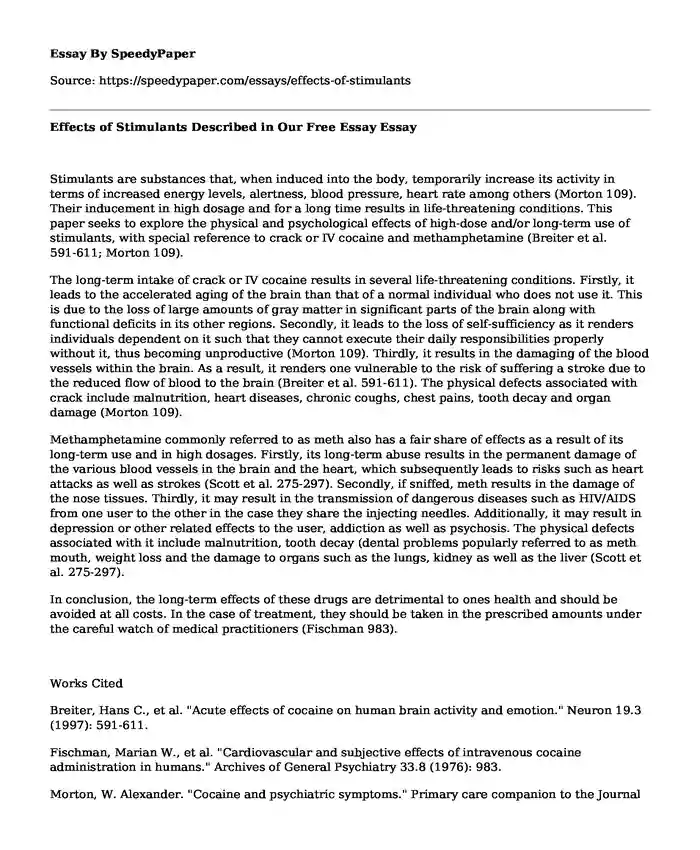Stimulants are substances that, when induced into the body, temporarily increase its activity in terms of increased energy levels, alertness, blood pressure, heart rate among others (Morton 109). Their inducement in high dosage and for a long time results in life-threatening conditions. This paper seeks to explore the physical and psychological effects of high-dose and/or long-term use of stimulants, with special reference to crack or IV cocaine and methamphetamine (Breiter et al. 591-611; Morton 109).
The long-term intake of crack or IV cocaine results in several life-threatening conditions. Firstly, it leads to the accelerated aging of the brain than that of a normal individual who does not use it. This is due to the loss of large amounts of gray matter in significant parts of the brain along with functional deficits in its other regions. Secondly, it leads to the loss of self-sufficiency as it renders individuals dependent on it such that they cannot execute their daily responsibilities properly without it, thus becoming unproductive (Morton 109). Thirdly, it results in the damaging of the blood vessels within the brain. As a result, it renders one vulnerable to the risk of suffering a stroke due to the reduced flow of blood to the brain (Breiter et al. 591-611). The physical defects associated with crack include malnutrition, heart diseases, chronic coughs, chest pains, tooth decay and organ damage (Morton 109).
Methamphetamine commonly referred to as meth also has a fair share of effects as a result of its long-term use and in high dosages. Firstly, its long-term abuse results in the permanent damage of the various blood vessels in the brain and the heart, which subsequently leads to risks such as heart attacks as well as strokes (Scott et al. 275-297). Secondly, if sniffed, meth results in the damage of the nose tissues. Thirdly, it may result in the transmission of dangerous diseases such as HIV/AIDS from one user to the other in the case they share the injecting needles. Additionally, it may result in depression or other related effects to the user, addiction as well as psychosis. The physical defects associated with it include malnutrition, tooth decay (dental problems popularly referred to as meth mouth, weight loss and the damage to organs such as the lungs, kidney as well as the liver (Scott et al. 275-297).
In conclusion, the long-term effects of these drugs are detrimental to ones health and should be avoided at all costs. In the case of treatment, they should be taken in the prescribed amounts under the careful watch of medical practitioners (Fischman 983).
Works Cited
Breiter, Hans C., et al. "Acute effects of cocaine on human brain activity and emotion." Neuron 19.3 (1997): 591-611.
Fischman, Marian W., et al. "Cardiovascular and subjective effects of intravenous cocaine administration in humans." Archives of General Psychiatry 33.8 (1976): 983.
Morton, W. Alexander. "Cocaine and psychiatric symptoms." Primary care companion to the Journal of clinical psychiatry 1.4 (1999): 109.
Scott, J. Cobb, et al. "Neurocognitive effects of methamphetamine: a critical review and meta-analysis." Neuropsychology review 17.3 (2007): 275-297.
Cite this page
Effects of Stimulants Described in Our Free Essay. (2019, Sep 09). Retrieved from https://speedypaper.net/essays/effects-of-stimulants
Request Removal
If you are the original author of this essay and no longer wish to have it published on the SpeedyPaper website, please click below to request its removal:
- Free Essay about Confusing Love with Obsession
- Nursing Essay Example: Use of Evidence-based Practice in the Clinical Site
- Andreas Ekstrom: The Moral Bias
- Free Essay Example: Environment Photo
- Essay Sample on Emerging Markets Consumer
- Essay Sample on Role of Free Higher Education
- Essay Sample on Key Messages of the IOM Report
Popular categories





